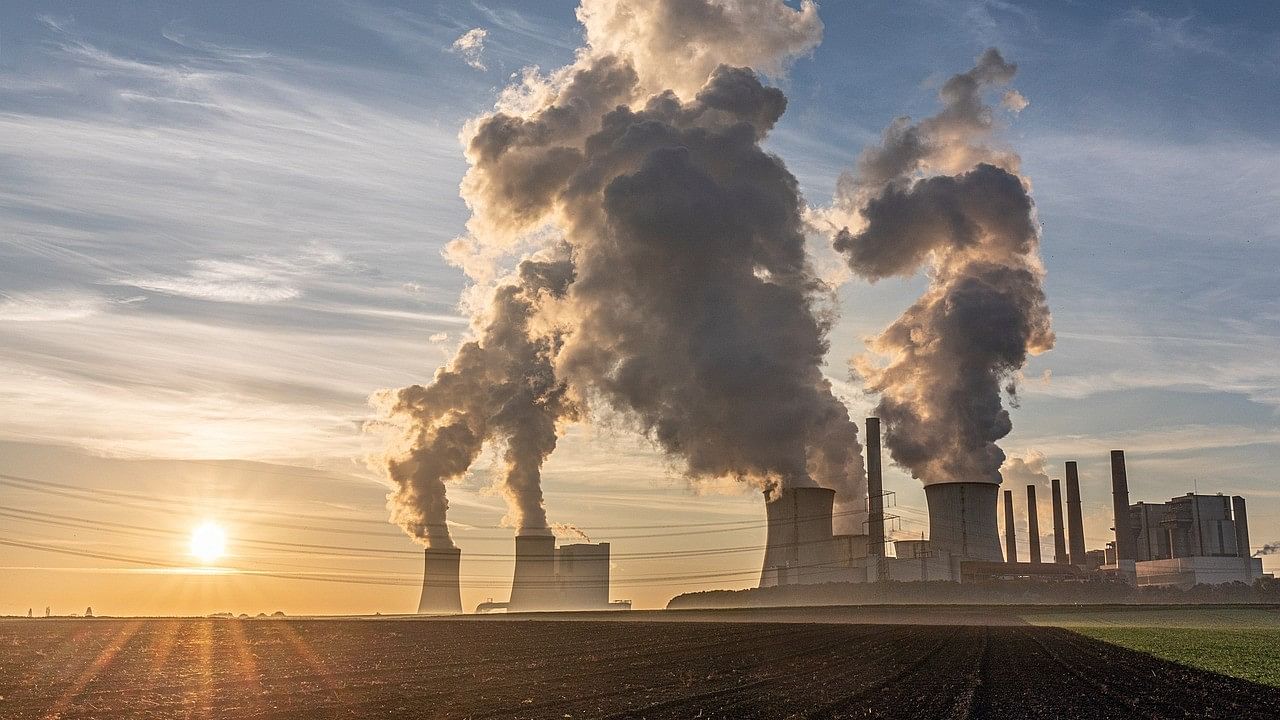
Representative image of pollution.
Credit: Pixabay Photo
Fossil fuels like coal, oil and gas release massive amounts of carbon dioxide (CO2) when they are burnt during power generation. CO2 is a greenhouse gas which traps heat and warms the planet.
We also have solar, wind and hydropower, which generate energy without releasing CO2. These renewable energy sources are powerful tools in the climate solutions toolbox. But there are also other tools like carbon dioxide removal (CDR) and carbon capture and storage (CCS), which focus on removing and storing CO2 instead of limiting the usage of fossil fuels.
CDR refers to removing CO2 from the atmosphere using both natural and technological means. The most prominent natural means is reforestation, where re-planted trees in degraded forest areas can help remove CO2 from the atmosphere and store it. Engineered means to do CDR include processes like direct air capture (DAC), which somewhat mimics the functionality of trees by extracting CO2 directly from the ambient air and storing it underground.
CCS is different from CDR since it captures CO2 at the source in the fossil fuel industry or in other industrial processes like steel and cement production. The latter is often considered “hard to abate”, meaning reducing emissions in this sector is not as easy as reducing emissions in the energy sector.
However, many experts consider CDR and CCS as distractions from the urgent need to drastically cut emissions by reducing dependence on fossil fuels.
A critical assessment
Recently, a group of scientists and researchers critiqued CDR in a comprehensive article for Nature. One of the most significant issues with CDR is scale. There is a high risk in assuming that CDR can be deployed at a large, planetary scale and it can remove hundreds of billions of tonnes of CO2. Therefore, one of the co-authors of the article termed CDR “a dangerous distraction from timely zero-fossil-fuel narratives.”
Emission reduction pathways outlined by the Intergovernmental Panel on Climate Change (IPCC), the premier body for climate science, rely to a great extent on the success of carbon removal techniques to limit warming. But there is a direct dissonance here, another scientist pointed out in the Nature article. “If the IPCC reduced the reliance on CDR in emission scenarios, the IPCC would report greater short-term net emission reductions, and mitigation policy would have to be re-calibrated to a different mix of mitigation measures. The mere existence of CDR in scenarios effectively delays emission reductions, a characteristic not existing for technologies that reduce emissions (such as solar power).”
CCS, too, throws a lifeline for the fossil fuel industry. Research published in 2018 in the Energy Research and Social Science journal showed a direct link between “Norway’s extraordinary enthusiasm” for CCS and “political compromise” regarding lesser climate ambition given its thriving oil and gas industry. It said the implication of CCS being “elevated to iconic status by successive Norwegian governments is that both represent formidable ideas, as opposed to formidably reduced emissions.” This goes back to a point made earlier in the report that CCS and CDR focus on CO2 and not fossil fuels, undermining the need to reduce reliance on fossil fuels rapidly and drastically.
The criticism about scale also applies to CCS, a technology that has been around for decades but has not delivered results. Worse, much of the CCS deployed today is used by the oil and gas industry for ‘enhanced oil recovery’, i.e. the CO2 captured via CCS is injected into oil fields for more efficient extraction of oil, thus defeating the climate purpose of capturing CO2 in the first place.
The other issue, which again correlates with scale, is the availability of land for CDR methods like reforestation. Often, land in the Global South in countries like Brazil, India and others in Africa is considered ideal for tree-planting. This can adversely impact land rights, especially those of already marginalised tribal communities and other issues like food insecurity if agricultural lands are diverted for planting trees.
The political push at COP28
On November 14, the US and China released a joint statement for COP28, which states they will cooperate "to advance at least five large-scale cooperative CCUS projects each by 2030". Last year, the US promoted CCS via legislation. According to estimates, the Inflation Reduction Act could increase the use of CCS 13-fold by 2030.
Last week, the EU parliament approved the Net-Zero Industry Act, which underscores, among other things, the need to "facilitate and enable carbon capture and storage projects and increase the availability of CO2 storage sites.” One of the EU climate chief's official responsibilities is to “intensify efforts on carbon capture, usage and storage”.
Alongside such legislative backing, the CCS industry will likely get a boost at COP28, as the oil industry has seemingly captured the climate talks. The Carbon Capture and Storage Association, a trade body that lobbies for CCS with oil giants like BP, ExxonMobil, Shell and TotalEnergies as its members, is officially registered as a business NGO at COP28. This is seen as a 'Trojan horse' of the oil lobby by climate activists.
The political push for CCS ought to be critiqued from a science and feasibility point of view. As for CDR, tree planting is widely seen and accepted as a legitimate solution to the climate crisis. But neither CCS nor tree-planting can create wonders unless we reduce our dependence on fossil fuels.